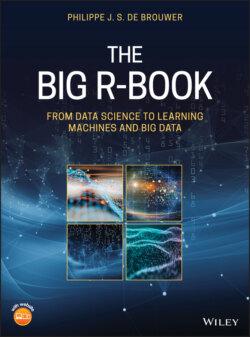Читать книгу The Big R-Book - Philippe J. S. De Brouwer - Страница 98
4.3.8.2 Accessing Information from a Data Frame
ОглавлениеMost data is rectangular, and in almost any analysis we will encounter data that is structured in a data frame. The following functions can be helpful to extract information from the data frame, investigate its structure and study the content.
summary()
head()
tail()
# Get the structure of the data frame: str(data_test) ## ‘data.frame’: 5 obs. of 4 variables: ## $ Name : Factor w/ 5 levels “Laura”,“Lisa”,..: 5 4 3 2 1 ## $ Gender: Factor w/ 2 levels “Female”,“Male”: 2 2 1 1 1 ## $ Score : num 78 88 92 89 84 ## $ Age : num 42 38 26 30 35 # Note that the names became factors (see warning below) # Get the summary of the data frame: summary(data_test) ## Name Gender Score Age ## Laura:1 Female:3 Min. :78.0 Min. :26.0 ## Lisa :1 Male :2 1st Qu.:84.0 1st Qu.:30.0 ## Paula:1 Median :88.0 Median :35.0 ## Pawel:1 Mean :86.2 Mean :34.2 ## Piotr:1 3rd Qu. :89.0 3rd Qu.:38.0 ## Max. :92.0 Max. :42.0 # Get the first rows: head(data_test) ## Name Gender Score Age ## 1 Piotr Male 78 42 ## 2 Pawel Male 88 38 ## 3 Paula Female 92 26 ## 4 Lisa Female 89 30 ## 5 Laura Female 84 35 # Get the last rows: tail(data_test) ## Name Gender Score Age ## 1 Piotr Male 78 42 ## 2 Pawel Male 88 38 ## 3 Paula Female 92 26 ## 4 Lisa Female 89 30 ## 5 Laura Female 84 35 # Extract the column 2 and 4 and keep all rows data_test.1 <- data_test[,c(2,4)] print(data_test.1) ## Gender Age ## 1 Male 42 ## 2 Male 38 ## 3 Female 26 ## 4 Female 30 ## 5 Female 35 # Extract columns by name and keep only selected rows data_test[c(2:4),c(2,4)] ## Gender Age ## 2 Male 38 ## 3 Female 26 ## 4 Female 30
